





| Name/Model# : | Imperial-II Class Star Destroyer |
| Designer/Manufacturer : | Kuat Drive Yards |
| Combat Designation : | Capital Starship |
| Length : | 1,600 Metres |
| Crew : | 37,085 |
| Skeleton Crew : | 5,000 |
| Cost of Vessel : | Not Available for Sale |
| Hyperdrive Rating : | Class 1 |
| Hyperdrive Backup : | Class 8 |
| Atmospheric Speed : | Cannot Enter Atmosphere |
| Cargo Capacity : | 36,000 Metric Tons |
| Consumables : | 6 Years |
| Weapons : | 50 Heavy Turbolaser Batteries
50 Heavy Turbolaser Cannons 20 Ion Cannons 10 Tractor Beam Projectors |
| Starfighter Squadrons : | 3 TIE Starfighter Squadrons
2 TIE Interceptor Squadrons 1 TIE Bomber Squadrons |
| Troop Capacity : | Full Standard Stormtrooper Division (9,700
Troops)
12 Landing Barges 20 AT-ATs 30 AT-STs 1 Prefabricated Garrison Base |
| Support Craft : | 8 Lambda Class Shuttles
15 Stormtrooper Transports 5 Assault Gunboats (StarWing Assault Gunboat) 5 Skipray Blastboats ? Gamma Class Assault Transports |
The Imperial-II Class Star
Destroyer has a heavily reinforced hull and stronger shields
than the Imperial-1 Class Star Destroyer.
They began to appear in service shortly after the Battle of Yavin. The
solar ionization reactor is literally a miniature sun, which provides more
than
enough power for the Star Destroyer, this
is also the same with the Imperial-1 Class Star Destroyer. These mobile
weapon platforms also act as mobile space stations, repair docks
and heavy transports for smaller craft. They
can engage whole Rebel Fleets or fleets of lesser
ships and still can expect victory. Deploying
an Imperial Star Destroyer and support craft the
Empire can virtually destroy any opposition
that it may face. It is impossible to garrison every
system in the Empire, however the ISD allows
the Emperor to project his power anywhere in
the Galaxy for a short period of time. Each
ISD holds one Prefabricated Garrison Base which
can be deployed for long-term planetary occupation.
Each base is equipped with 40 TIE
Starfighters, 10 AT-ATs, 10 AT-STs and 800
troops. Full planetary invasion usually requires a
full fleet of 6 ISDs, heavy and light cruisers,
as well as carrier ships.
Also known throughout the galaxy as the Emperor's capital ships, Imperial Star Destroyers provide the main military might of the Empire. Built by command of Palpatine at a rate that forced all normal safety precautions to be discarded, these vessels served to establish the primary foothold of the Emperor's rule.
These colossal, wedge-shaped behemoths, bristling with turbo weapons and carrying entire TIE squadrons within them, each possess more firepower then the entire planetary force of most worlds, and can reduce a planet surface to smoking debris in a matter of hours. An Imperial Star Destroyer, typically 1.6 kilometers in length, is equipped with 60 turbolasers emplacements and 60 ion cannon batteries. Each turbolaser is a supercharged beam weapon that uses a small laser to excite its main component system to fire. A turbolaser's beam is hotter and more intense then that of an ordinary blaster cannon, and it's discharge muzzle reaches such high temperatures that three separate cryogenic cooling systems are necessary to keep the weapons within safe thermal limits. The vessel's ion cannons, similar to those most often found as a part af planetary defensive systems, give the Star Destroyer the ability to neutralize the energy systems of other vessels as an aid to capture and boarding.
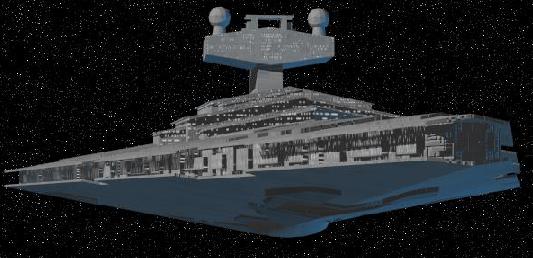 A Star Destroyer also carries three TIE fighter squadrons for perimeter defense and reconnaissance, two Tie interceptor squadrons, one TIE bomber squadron, eight Imperial shuttles, a full stormtrooper division and 15 stormtrooper transports, building materials, landing barges, scouts, field artillery weapons, both AT-AT and AT-ST walker groups (for ground assault missions), special ablative heat shield for orbital drops, assault gunboats, repair vessels, deep-space probes and probe droids, 10 tractor beam projectors, defensive shields, and sophisticated sensor and communications arrays.
A Star Destroyer also carries three TIE fighter squadrons for perimeter defense and reconnaissance, two Tie interceptor squadrons, one TIE bomber squadron, eight Imperial shuttles, a full stormtrooper division and 15 stormtrooper transports, building materials, landing barges, scouts, field artillery weapons, both AT-AT and AT-ST walker groups (for ground assault missions), special ablative heat shield for orbital drops, assault gunboats, repair vessels, deep-space probes and probe droids, 10 tractor beam projectors, defensive shields, and sophisticated sensor and communications arrays.
The vessel's upper command tower with its characteristic twin sensory and rangefinding domes serves as the brain of the ship. The main bridge, located in then center of the tower's forward face, features large viewports which provide a spectacular view of space beyond and of the massive forward hull. As they do in many Imperial vessels, flight data officers, tracking systems specialists and combat supervisors work in sunken data pits that line the room's floor.

The ventral side of the Imperial Star Destroyer features two launch bays, both along the vessel's centerline. The largest of these is of sufficient size to allow the docking/capture of any vessel at or below the dimensions of a Corellian Corvette (or Blockade Runner, as it is sometimes called). From this same bay, the ship's TIE squadrons and probes are launched as well, dropping from holding recks along the wide, vertical shaft that reaches well into the main body of the ship.
A smaller launch bay, just forward of the main one, serves as a drop chute for any ground assault equipment the vessel chooses to deploy. Three AT-AT walkers can be dropped per minute, carried in landing barges and unloaded. Such large ground equipment is later retrieved using standard mega-lift cargo modules and specially-outfitted shuttle barges. Alternately, when time is not a factor, walkers can be both delivered to and removed from a combat zone by shuttle barge carrier.
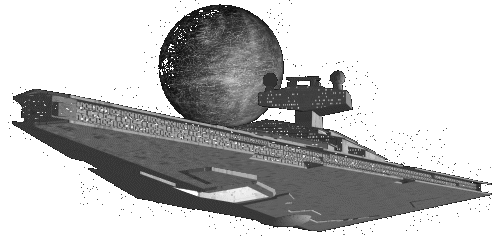 The ship's huge hyperspace field generator is located within a domed area along the vessel's ventral ridge. It is the largest such generator ever constructed, and it expends more raw energy in a single hyperspace jump than many planetary nations use during their entire life time. Containing what is in essence a miniature sun, the heavily-shielded, carbonite and durasteel-reinforced heart of the ship's SFS 1a2b solar ionization reactor was the one element that dictated the enormous size of the Imperial Star Destroyer. It feeds not only the hyperdrive motivation system., but the vessel's propulsion, powerfeed and weapons networks as well, providing more than enough focused power for any task facing a Star Destroyer.
The ship's huge hyperspace field generator is located within a domed area along the vessel's ventral ridge. It is the largest such generator ever constructed, and it expends more raw energy in a single hyperspace jump than many planetary nations use during their entire life time. Containing what is in essence a miniature sun, the heavily-shielded, carbonite and durasteel-reinforced heart of the ship's SFS 1a2b solar ionization reactor was the one element that dictated the enormous size of the Imperial Star Destroyer. It feeds not only the hyperdrive motivation system., but the vessel's propulsion, powerfeed and weapons networks as well, providing more than enough focused power for any task facing a Star Destroyer.
The standard Star Destroyer carries a complement of 37,085 (4,520 officers, 32,565 enlisted). Much of it's interior space is necessarily dedicated to providing quarters for this enormous crew, and other areas (unlike most Imperial ships) feature recreation facilities for off-duty personnel. In addition, quarters are provided for the vessel's always-ready planetary assault troops and for any Imperial VIPs or planetary government officials who the Emperor feels should spend time as "guests" aboard one of his massive and intimidating Imperial Star Destroyers.
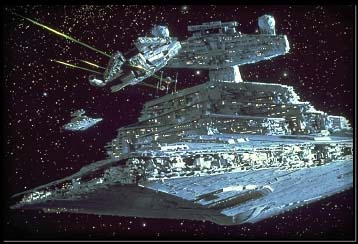 There are no raw materials recycling facilities aboard Imperial Star Destroyers, as there are within Dreadnaughts and Super Star Destroyers. As a result, most commanders simply eject repair debris and wast materials into space, usually before engaging the vessel's hyperdrive systems.
There are no raw materials recycling facilities aboard Imperial Star Destroyers, as there are within Dreadnaughts and Super Star Destroyers. As a result, most commanders simply eject repair debris and wast materials into space, usually before engaging the vessel's hyperdrive systems.
A Sector Group of 24 Imperial Star Destroyers is assigned for the patrolling of each sector of space. With the added reach of Tie squadron patrols, a single vessel can easily hold a star system within its grip, forcing it's inhabited worlds to comply with any Imperial edict that is handled down. The placement of stormtrooper patrols on planetary surfaces is seldom necessary, but it is an option left to each Star Destroyer commander.
Many people assume that the two globes set atop the command tower of a star destroyer are deflector shield generators. This is almost certainly wrong. The best evidence indicates that they are sensor systems instead.
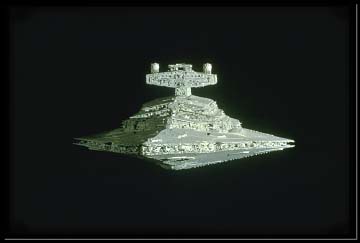 At the climax of the Battle of Endor a concerted A-Wing attack led to the explosive destruction of one of these globes on the Executor. This damage also coincided with a breakdown of the bridge deflector shields, which is the reason for the common prejudice regarding the function of the globes.
At the climax of the Battle of Endor a concerted A-Wing attack led to the explosive destruction of one of these globes on the Executor. This damage also coincided with a breakdown of the bridge deflector shields, which is the reason for the common prejudice regarding the function of the globes.
On all other starships the deflector shield generators are hidden internal devices. They do not need to be perched up high away from the main hull. If the star destroyer globes were deflector shields or if shield generators took any advantage from being prominently placed on a vessel's outer hull then we would expect to see similar structures on rebel capital ships and other vessels. We do not. The domes must be some non-critical system which can afford exposure in a vulnerable location. Furthermore, if the globes really were deflector shield generators then they would themselves be sufficiently shielded to withstand missile attacks from mere starfighters.
The failure of Executor's bridge deflector shields coinciding with a globe's destruction may merely indicate that the damage to one system affected power to the other in an unanticipated way. Note that only one of the globes was damaged. If the globes on the command tower were the actual shield generators then both would have to be damaged or destroyed before the bridge shields were wholly lost. (It should also be noted that the globes on the bridge tower were only two out of at least eight that can be seen in that neighbourhood of the dorsal hull.) At best, Executor's demise says more about a flukey and synergistic system failures than any functional connection between globes and shields.
( If you do not believe that - click here )

Situated between the long-range scanner globes there are two large stubby towers about thirty to fifty metres thick. Across the tops of these towers is a feature consisting of two long linear structures joined by an "X"-shaped brace. In form it resembles a kind of large linear antenna. Its position atop the bridge tower suggests that, like the long-range scanner globes, it serves a function for which an uninterrupted line of sight over most of the sky is the prime consideration. In other words, this also seems likely to be a device for communications or sensor functions.
This array is another possible indicator of different classes of Imperial combat starships. On the ISD-I ships the array is usually mounted high and tall, protruding well above the height of the sensor globes. On all the later vessels the array is always more compactly and discreetly settled below the scanner globes in a horizontal orientation. Whether this indicates a difference of the capabilities of the ship subclasses remains open to speculation. It is interesting to note that the ISD-I destroyers engaged in the siege of Hoth had lowered arrays too. This may be the result of a modernisation refit, or a mission-specific modification; or the array may actually be jointed and directible.
It is generally acknowledged that the tower on an Imperator-class destroyer is the same size as that of the Executor. This structure performs the same function on both ships, and the requirements of these functions do not vary with the total size of a vessel. Furthermore the two types of bridge towers share the same basic proportions, and most of their structural detail.
Calculations of the length of the Executor starting with the assumption that the bridge towers are the same size are in close agreement with independent length estimates based on the geometry of images in which a star destroyer overlaps the command ship. It seems clear that the artists responsible for the films intended the bridge size to be a constant, thereby giving the audience a visible and uniform cue to the scale of the ships.
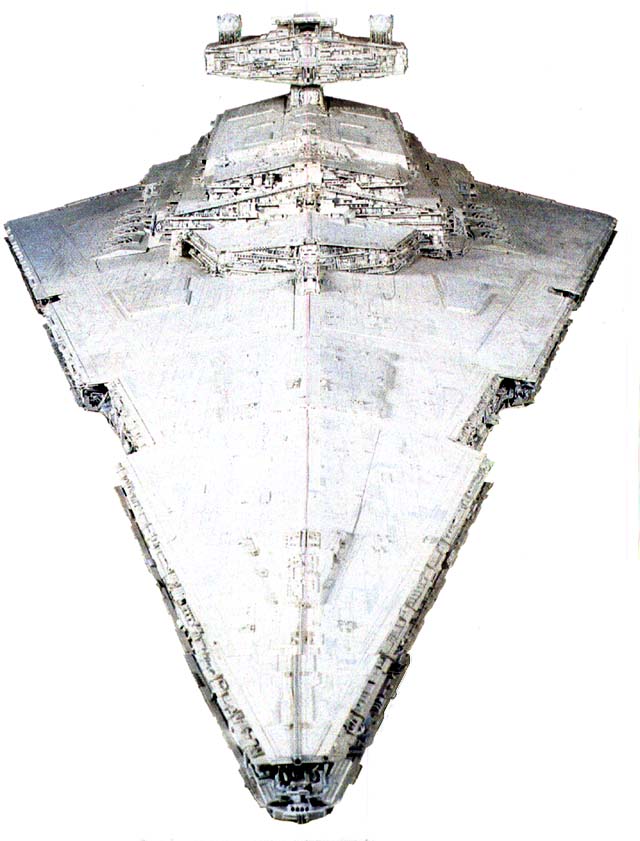



Navigation Bar
Home
Intro & Biography
Brief Characterization
Personal Quotes
Thrawn's Mind Reader